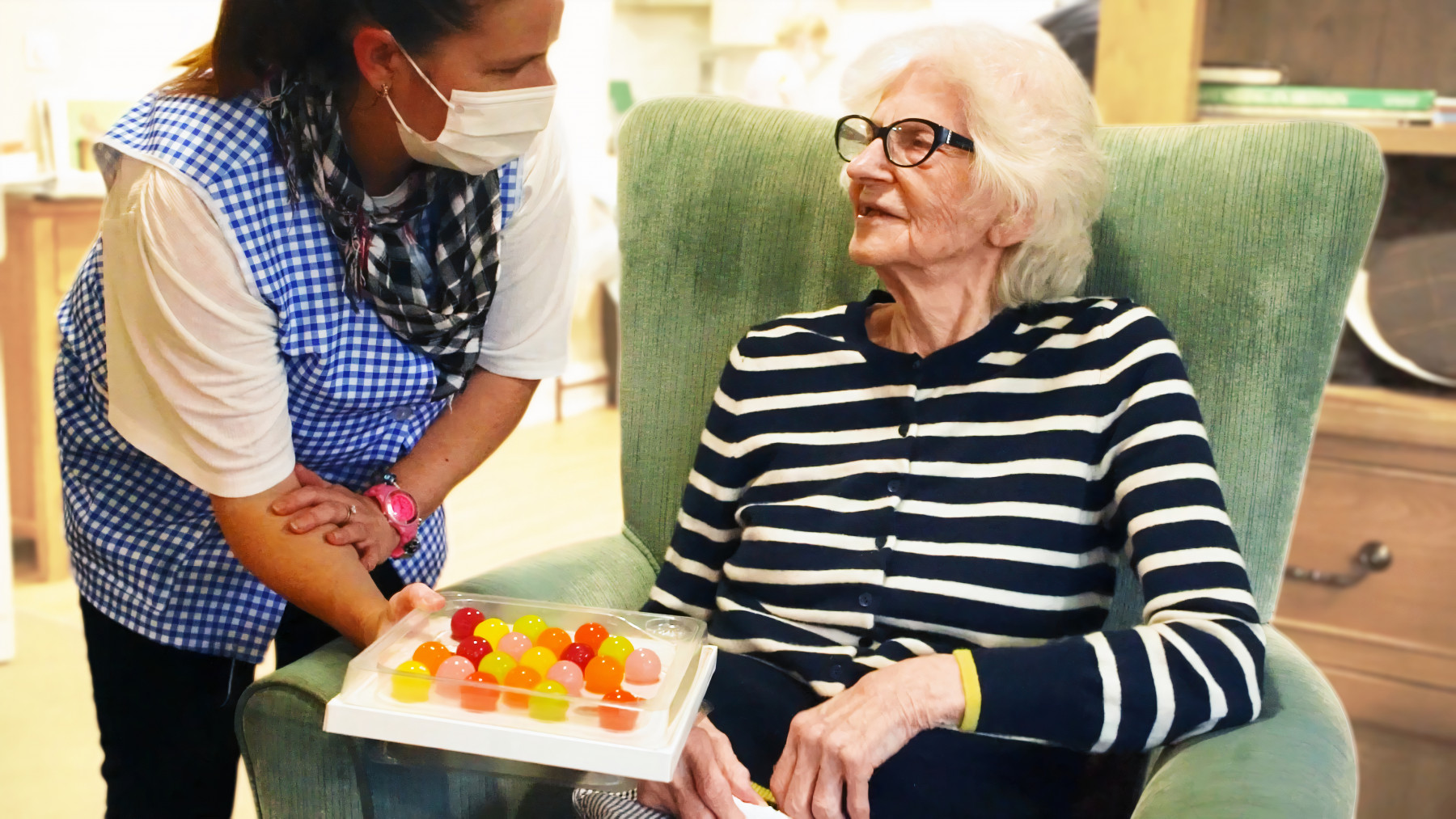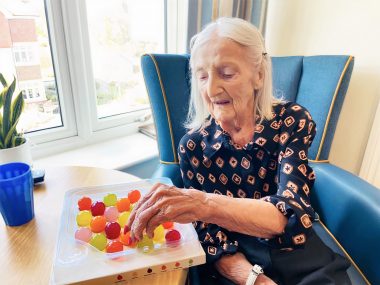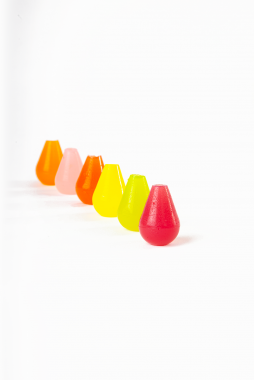For Dementia Patients Who May Forget to Stay Hydrated — ‘Jelly Drops’

A nurse offers a patient a Jelly Drops tray. (Courtesy of Jelly Drops)
When Lewis Hornby’s grandmother was rushed to the hospital in 2018, his family feared the worst.
Pat Dickinson suffered from dementia, but in this instance it turned out that she was simply dehydrated. Once she got some fluids in her, she bounced back. But what happened to his grandmother gave Hornby an idea about how to help people with Alzheimer’s and dementia remember to stay hydrated.

A dementia patient reaches for a Jelly Drop. (Courtesy of Jelly Drops)
Jelly Drops, officially launched by Hornby and two other co-founders in 2020, has expanded across the U.K. and recently began distributing in the U.S. The colorful Jell-O-like drops are sweet and made with water, giving people with dementia an easier way to get the hydration they might need.
“In the care home, I really wanted Jelly Drops to tackle dehydration and also to be really fun and engaging and sort of a social tool in the care home as well,” Hornby said in a video interview with Alzheimer’s News Today.
Hornby created the forerunner to Jelly Drops for his master’s graduation project at Imperial College London and Royal College of Art in 2018, based on his grandmother’s near-death experience. He had help from other students in the program, two of whom now work full time for the company, which has now produced over four million drops.
A video of Hornby’s grandmother eating seven drops in 10 minutes went viral after being shared across dementia support Facebook groups through the summer of 2018. The video was first offered at the presentation for the Dyson School of Design Engineering at Imperial College London’s DESIRE award for social impact; DESIRE stands for Design Engineering Selected Innovation Recognition.
According to Hornby, the video has now reached 100 million views, thanks to distribution on platforms such as YouTube and Reddit and by news outlets ATTN:, NowThis, Sky News, and the BBC.
“I really didn’t expect it to sort of take off the way it did, and basically, within a couple of months of graduating, I was getting thousands and thousands of emails, asking where people could get it,” Hornby said. “And at that point, I was still making it in my kitchen.”
What also makes Jelly Drops unique is their creation process. Instead of a water-filled sack in the middle, the drop is solid all the way through, with the water incorporated into the structure itself. They are vegan, gluten-free, and sugar-free, much to the delight of Hornby’s mother, a dentist. Care centers can store drops unrefrigerated for up to four weeks.
Jelly Drops are also presented in trays that make it easier for people with dementia to pick them up, as the drops have a somewhat slimy texture owing to their high-water content.
“There is something beautifully simple and attractive about Jelly Drops,” Colin Capper, associate director of evidence and participation for the Alzheimer’s Society, said in a video interview. “There’s something really attractive about the color, the shape, and the taste and texture of Jelly Drops.”
They also address a real need among dementia patients.
In meeting with dementia specialists, Hornby discovered that people with dementia may lose the ability to feel thirsty. According to a study from the American Journal of Alzheimer’s Disease & Other Dementias, 51% of long-term care residents had documented cases of dehydration.
Some people who are extremely dehydrated, like Hornby’s grandmother was, are admitted to the hospital. About 25% of hospital beds in the U.K. are occupied by dementia patients, Capper said.
“If we can begin to reduce the likelihood of people being dehydrated and admitted to hospital unnecessarily, that could have very profound effects on an individual and system level,” Capper said.
So far, Hornby has developed two lines of Jelly Drops: the Original Tray and Snackpot. The tray features 24 drops of every berry and citrus flavor, with colors including orange, red, purple, and green. The Snackpots are sold in 21 individually wrapped containers that include five drops. In the U.S., each tray starts at $9.99 while each Snackpot starts at $1.66 for subscribers. The price increases a few dollars if a customer does not choose the subscription service.
Jelly Drops included in the trays have 12.5 milliliters of water, while the smaller Snackpots have 10 ml.
The Alzheimer’s Society Accelerator Programme allowed Hornby to fine-tune his design process based on community input. That initiative, which began three years ago, gives up to £100,000 (about $125,000) in investment toward a product or idea, an “innovation buddy” to further develop the product over a period of 12 months, and an opportunity to test the product among people with dementia.
Jelly Drops checked all the boxes for the accelerator, according to Capper, who leads the program. The product was desirable, impactful, and scalable, he said, and was one of the program’s first round of partners.
Jelly Drops also had something else Capper was looking for — “sparkiness,” or how committed the team was to its idea.
“Lewis was inspired by his grandmother’s experience, and that passion and energy really came through to us when he talked about what he wanted to do,” Capper said.
Jelly Drops has also won a host of awards, including the Global Entrepreneur of the Year at Pitch@Palace Global 4.0, a networking platform for U.K.-based entrepreneurs, and the People’s Choice Award at the 11th St. James Palace Pitch@Palace. They were also awarded the Meaning-Centred Design Award for the student-healthcare category and the Helen Hamlyn’s Snowdon Award for Disability, named after the wife of British publishing tycoon Paul Hamlyn.
Part of the reason for Jelly Drops’ success is because of their simplicity and the fact that anyone, regardless of disability, can use the drops to stay hydrated, Hornby said.
“In the process of me speaking with caregivers, speaking with families, I didn’t want the product to be sort of overly medicalized,” Hornby said. “Jelly Drops are sweets that anyone can enjoy. It just happened to be designed with people with dementia in mind.”

A lineup of brightly colored Jelly Drops. (Courtesy of Jelly Drops)
Hornby plans to continue improving Jelly Drops so they are easier to use for people with Alzheimer’s and dementia. The company continues to fulfill orders in the U.S. and U.K. and has 50,000 people on its mailing list.
“To see them be able to move from manufacturing Jelly Drops literally in a shared flat to having a factory and being able to make these products available to thousands and thousands of people now across two countries is wonderful,” he said.
Dickinson died in 2020, but Hornby’s grandmother lives on through Jelly Drops’ official branding — “Pattinson’s Jelly Drops.”








